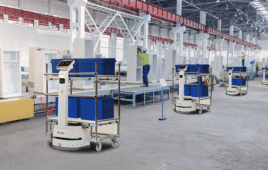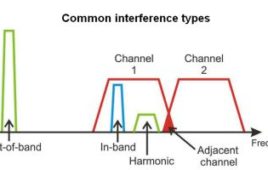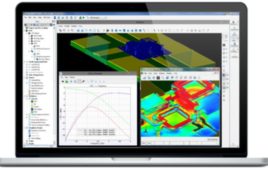 In the automotive industry, manufacturers are working on production concepts that eliminate the need for fixed conveyor equipment such as assembly belts and suspension tracks. In their test factories, several car manufacturers are currently acquiring experience with such concepts. The Fraunhofer Institute for Manufacturing Engineering and Automation (IPA) has also set up a test factory with an AGV-based car manufacturing area in the Arena 2036 research centre. And not very far away, in a suburb of Stuttgart, the Porsche Taycan will be built according to this principle from the end of this year.
In the automotive industry, manufacturers are working on production concepts that eliminate the need for fixed conveyor equipment such as assembly belts and suspension tracks. In their test factories, several car manufacturers are currently acquiring experience with such concepts. The Fraunhofer Institute for Manufacturing Engineering and Automation (IPA) has also set up a test factory with an AGV-based car manufacturing area in the Arena 2036 research centre. And not very far away, in a suburb of Stuttgart, the Porsche Taycan will be built according to this principle from the end of this year.
Porsche is abandoning the assembly line principle and, as the first vehicle manufacturer to do so, turning to AGV for serial production in a continual flow process. The new production method, currently being tested and shortly to be put into practice, requires new hardware, e.g. suitable AGV, and also a new type of communication. After all, essential elements of the new equipment are mobile. This is not only true of the AGV on which the vehicles are built, but also — depending on the individual concept — of the mobile transport units which supply the AGV assembly points with materials.
The steute business unit Wireless has developed a remote network for precisely such tasks, i.e. the exchange of data between sensors in the mobile units and the superordinate IT infrastructure. This network comprises wireless and network-compatible terminal devices (position switches, foot switches, magnetic sensors…) which transmit information to Access Points. Each Access Point can integrate up to about 100 network-compatible terminal devices in the network, and the overall network can include numerous Access Points. A Sensor Bridge acts as a service manager, linking the data generated at the production level to the customer IT infrastructure. Configuration of the Sensor Bridge is web-based via a central dashboard. This means that users are able to adapt the different functions of the wireless network to their individual requirements. An added advantage of the network is that it can be used for various applications, e.g. for AGV fleets and mobile eKanban systems.
Compatible with different wireless standards
 Originally, steute operated its wireless network exclusively with sWave.NET, its own wireless technology. It belongs to the class of Low Power Wide Area Networks (LPWAN) and its benefits include low-energy operation in conjunction with a long range, even in unfavorable conditions, as well as high transmission reliability. As a result, the wireless sensors achieve battery lifetimes of up to 10 years.
Originally, steute operated its wireless network exclusively with sWave.NET, its own wireless technology. It belongs to the class of Low Power Wide Area Networks (LPWAN) and its benefits include low-energy operation in conjunction with a long range, even in unfavorable conditions, as well as high transmission reliability. As a result, the wireless sensors achieve battery lifetimes of up to 10 years.
The high transmission reliability is guaranteed by multiple transmission: if transmission to the first Access Point should fail for any reason, the second Access Point is addressed, and so on. In some applications users would prefer to ignore these benefits, however, and continue using their existing platforms for transmission of the wireless signals, such as their own Wi-Fi network. This is why the steute wireless network has now been opened up under the umbrella term ‘nexy’ to provide a technology-independent platform for wireless transmission and reception of sensor data from the shop floor level to the company IT (AGV management, WMS, PDA, MES, ERP) and beyond, to the IoT. Some nexy interfaces, e.g. to the fleet management software of several AGV manufacturers, are already in use. A further software module — an eKanban system — is now also ready.
Wireless network for AGV fleets
The company dpm Daum & Partner Maschinenbau GmbH is specialised in AGV systems for the automotive industry and, with its Vision E, has developed a new AGV concept especially for the assembly of electric cars. According to the manufacturer, one of the unique features of Vision E is on-board safety technology which facilitates assembly work around the vehicle in continual uninterrupted flow, for the first time. Another special feature of this AGV concept is its energy-efficient battery management system. When the factory closes down, which can be for up to three weeks at a time, the entire AGV system can be put into a deep-sleep mode in which the power supply is completely shut off. This has the added benefit that the individual AGV do not have to return to a central charging point, but can just stay wherever they are.
During this downtime period, only a buffer battery is in operation, powering a wireless receiver. This receiver triggers the restart of the AGV as soon as it has received a corresponding signal via the sWave.NET wireless network. In previous systems, power was supplied to each individual vehicle by batteries which after long breaks sometimes had to be recharged. In addition, dpm can (and will) use the nexy AGV interface for other AGV models and fleets.
Several applications – one wireless technology
In a next step, the wireless network could assume additional functions … e.g. the management of replenishment supplies to vehicle assembly points. In this case, stationary or mobile eKanban racks — which could likewise be on AGV — would detect occupancy or the removal of containers and pass on this information to the material flow management system. Wireless sensors could also be installed at the transfer points between stationary and mobile conveyor equipment, signalling to an AGV that a container is ready to be transported, generating a corresponding pick-up order or commanding an AGV to start moving.
Steute Technologies
www.steute.com
Filed Under: Wireless • 5G and more




